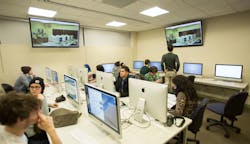Technology, Engineering Proficiency Under 50% among 8th Graders
In 2014, the National Assessment Governing Board tested over 21,500 eighth-grade students on their abilities to apply engineering, physics, and technology knowledge to solve standardized problems. The data and scores were discussed by a panel yesterday, May 17. For an extensive rundown of the test’s framework, click here.
The test was administered at over 800 public and private schools across the U.S. On a scale of 0-300, the overall average score was 150, and only 43% of students performed at or above the proficient level.
The results were compiled in the National Center for Education Statistics’ (NCES) first Nation’s Report Card for Technology and Engineering Literacy (TEL). According the NCES, proficient students should “understand the interactions among parts within systems, systematically develop solutions, and contribute to teams (assessed virtually) using common and specialized tools to achieve goals.”
The test covered three content areas: technology and society, design and systems, and information and communication technology. Three practices were also covered: understanding technological principles, developing solutions and achieving goals, and communicating and collaborating. Questions were based on real-life scenarios and administered via computer.
Other Results
The test’s questionnaire also recorded how students most commonly find themselves obtaining technical knowledge.
Results show that 52% of students learn and remember engineering and technology principals from taking classes in school;
59% said they sometimes learned about engineering and technology in school;
63% said they learned from family members how to build things, fix things, and how things work.
19% taught themselves
13% reported that they learned from their teachers.
Here is a sample question from the test, regarding iguanas. Scroll to the bottom of the page to try it out. As students click through the interactive module, they need to digest bite-sized information about the scenario and watch a couple videos. A page containing PDFs with results and more information about the test can be found here. Here are more overall results.
About the Author
Leah Scully
Associate Content Producer
Leah Scully is a graduate of The College of New Jersey. She has a BS degree in Biomedical Engineering with a mechanical specialization. Leah is responsible for Machine Design’s news items that cover industry trends, research, and applied science and engineering, along with product galleries. Visit her on Facebook, or view her profile on LinkedIn.

